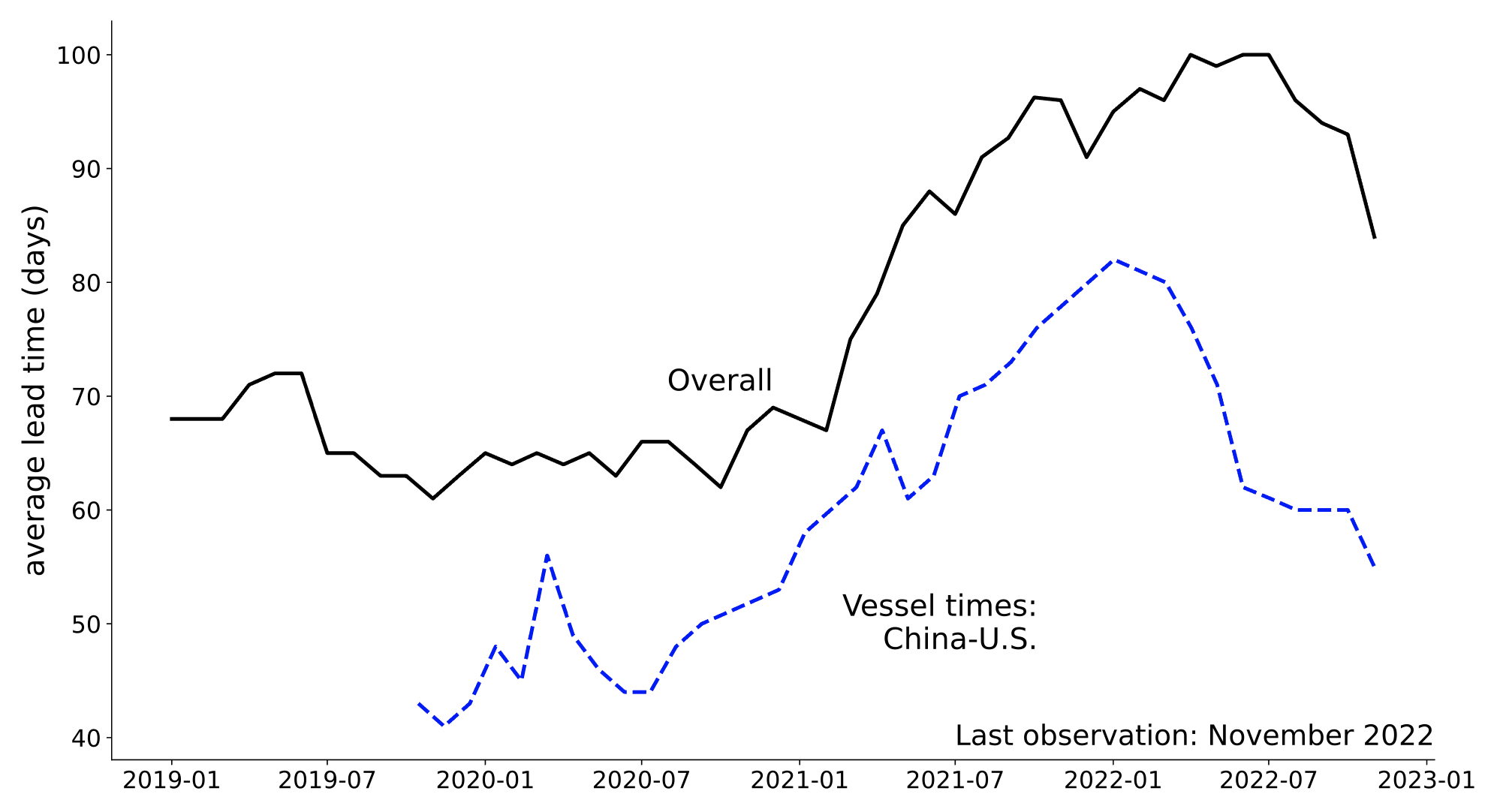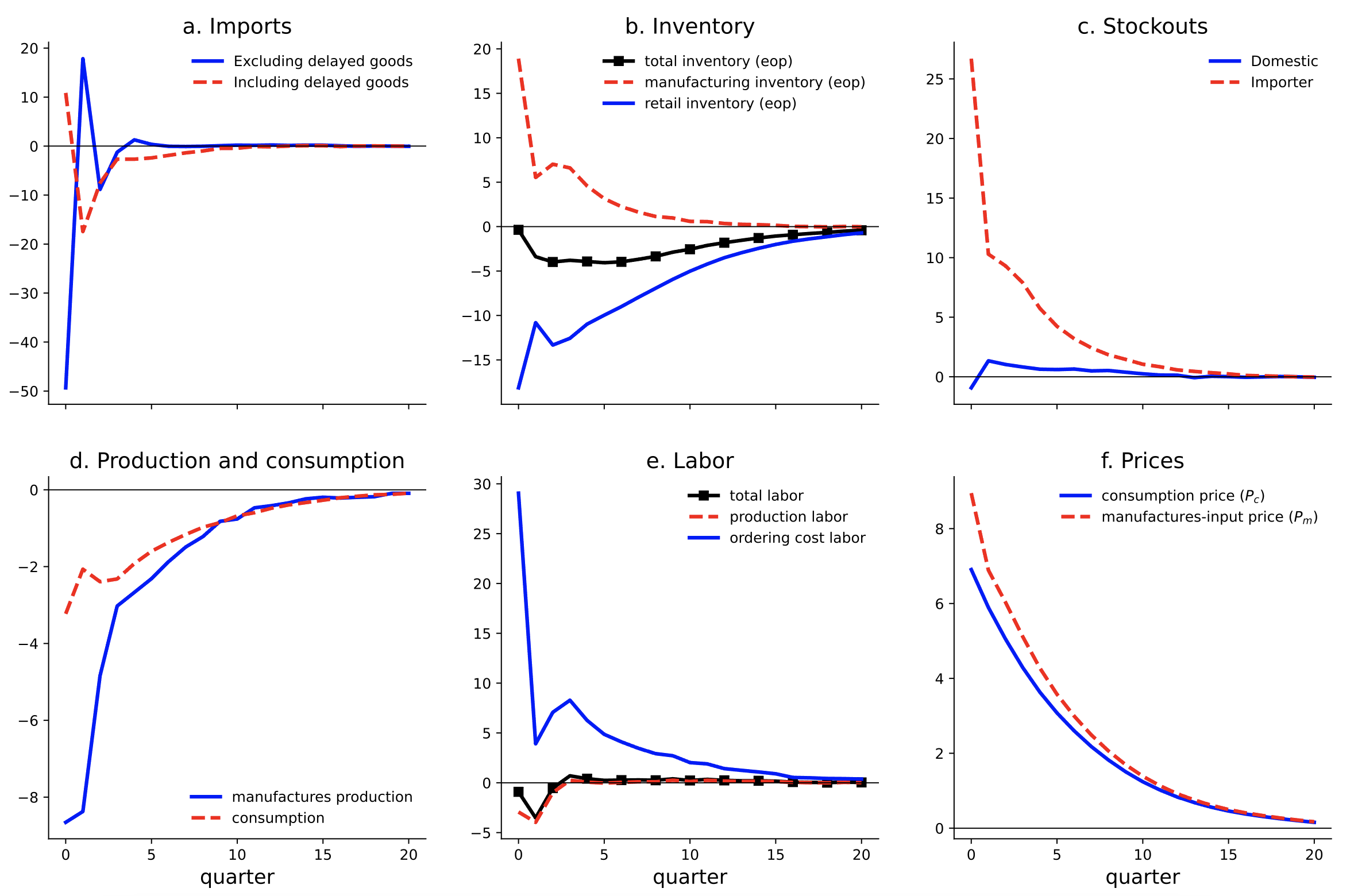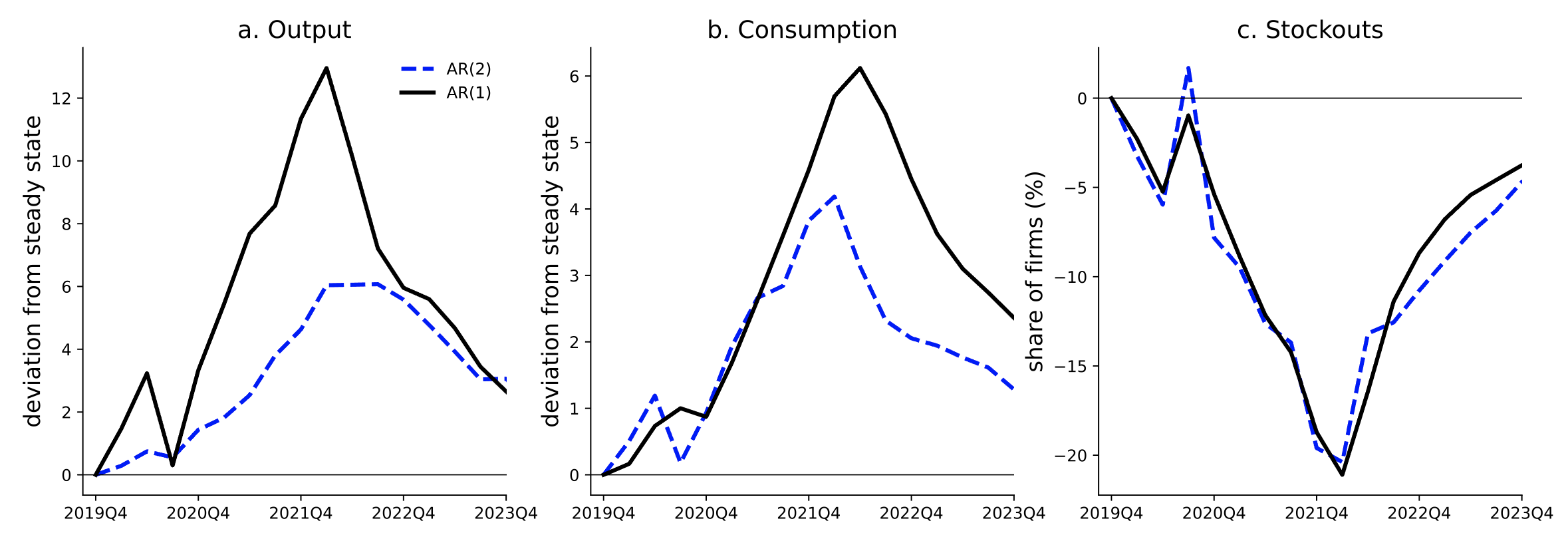A key disruption of the pandemic is that it became increasingly difficult for firms and consumers to buy goods in a timely fashion. Consumer stockouts were pervasive (Cavallo and Krystov 2022) and lead times, the time between placing an order and its delivery, rose. According to a survey of US purchasing managers by the Institute of Supply Management this measure went from 65 days in March 2021 to 100 days by the end of 2021 and remained elevated throughout 2022 (see Figure 1). These delays were globally widespread. While these delays were the result of a confluence of factors, a key component was an increase in shipping times, especially on international transactions. For example, oceanic transit times between China and the Western US increased from an average 45 days prior to Covid to more than 80 days at its peak. Further challenging firms’ capacities to absorb increases in lead times were the substantially depleted inventory levels caused by the large production cuts but only modest consumption declines in the early stages of the pandemic.
Figure 1 Lead times
Two literatures, which are mostly micro evidence-based, suggest that aggregate shocks to the availability of inputs have potentially large macroeconomic effects. First is the robust empirical evidence that local shocks to upstream producers have large impacts on their downstream buyers’ revenues and output (Boehm et al. 2015, Barrot and Sauvagnat 2016). Second, the trade literature has documented that trade is declining in the time it takes to deliver goods (Feyrer 2019, Djankov et al. 2010, Hummels and Schaur 2013). These two facts suggest that the aggregate effects of the post-pandemic delays are large. While recent work on the macroeconomic effects of Covid has emphasised the importance of production networks (Bonadio et al. 2021, Cakmakli et al. 2021), the analysis of these delays abstracts from both the time to source inputs and the use of inventories to buffer against delays or aggregate shocks.
In a recent paper (Alessandria et al. 2022a), we quantify the macroeconomic effects on the US and the global economy of transitory increases in global and local delivery delays between 2020 and 2022. Our framework includes a rich set of sourcing frictions and salient shocks that characterise the pandemic economy. We employ a two-country version of the heterogeneous firm model of Alessandria et al. (2022b), which extends the two-country inventory model of Alessandria et al. (2010a) to include an input-output structure and sectoral heterogeneity in the use and consumption of domestic intermediates. Key features of this framework are the differential costs in time, resources, and risk of local and global production networks. These frictions create differences in the inventory management of firms using local and global supply chains, which we use to discipline the parameters of the model.
Each country consists of three sectors: (1) a manufactured-good sector that combines labour and intermediate goods, (2) a consumer-goods sector that uses intermediate goods to produce, and (3) a retail/wholesale sector (retail from now on) that consists of two continua of firms, one that buys from the domestic manufacturer and one that imports from the foreign manufacturer. Retailers produce a differentiated variety, compete monopolistically, and sell to manufacturers and consumer-goods producers. They face two sourcing frictions: first, to order inputs they pay a fixed ordering cost that leads to infrequent orders and costly inventory holdings. Second, delivery times are uncertain. Orders stochastically arrive in either the current or the next period. The probability with which the shipment is delayed can vary and is the source of the delay ‘shock’ that we study. Firms that have delayed orders are constrained by their current inventory holdings, in which case they increase their prices as they stockout. Firms also face idiosyncratic demand shocks. The sourcing frictions and shocks to demand and supply lead firms to hold inventories to guard against stocking out and missing sales.
The steady state of the model is calibrated to reproduce features of the US and Rest of the World (ROW) economies prior to the pandemic. We discipline the key frictions, the order costs and delays, to match differences between global and local supply chains from Alessandria et al (2010b) and Khan and Khederlarian (2021). In steady state, import delays are 55 days and domestic delays 35 days.
Our benchmark assessment of the aggregate effects of delays considers an increase in international delivery times from 55 days to 90 days, mirroring the increase in oceanic transit times between China and the US. We model the shock as unanticipated, observed before orders are placed, transitory, and persistent.
Figure 2 International delay shock (percent change from steady state)
Figure 2 shows the response of aggregate variables to the import delay shock. Panel (a) plots the response of imports, separating the response of orders—imports including delayed goods—and delivered goods, which excludes delayed goods. On impact, there is a sharp decline in delivered goods, as only goods ordered and delayed from the previous period arrive. At the same time, orders spike as firms rush to order to avoid being constrained in the future. This anticipatory behaviour leads to a sharp reversal in delivered imports in the period following the shock and is reminiscent of the rush to obtain goods for the holiday shopping season months earlier than normal that we witnessed in mid-2021 and mid-2022.
The sharp import drop is mitigated by a drawdown of inventories. In turn, lower inventory levels lead to elevated stockouts, as more retailers are constrained by their inventories on hand (see panel c). Panel (d) shows that these effects lead to a large contraction of production and consumption, as inputs for manufacturers become unavailable and the prices of imported inputs increase. The drop is larger in production because trade is intensive in intermediate goods and consumption smoothing motives. In addition, there is a significant drop in hours worked, as labour demand drops due to the complementarity between labour and inputs, although the effect is partially mitigated by the increase in labour used to pay the ordering costs of retailers. These effects are more persistent than the shock itself because it takes retailers time to re-stock.
Panel (e) plots the response of the different prices in the model. Given the delays are only in international shipping, the largest price increases are in the price index of imported varieties as retailers selling imported varieties face higher carrying costs and more frequent stockouts. Since trade is intensive in intermediates, the input prices for manufacturers (red) increase by more than the consumption price index (blue). Moreover, due to the roundabout structure of production, the increase in input prices for the manufacturer ripple through the supply chain. Hence, although our framework considers only relative prices, it justifies the concerns about the link between supply chain disruptions and inflation that have been at the forefront of policy discussions (di Giovanni et al. 2023).
Our findings are driven by two effects. The first is the cost channel: Delays increase input costs in the form of depreciation and interest incurred in transit as well as the ordering costs from the anticipatory stockpiling. The second is the quantitative restriction channel: delays lead more firms to stockout and this lack of goods ripples through the supply chain. We find this latter channel is the key source of the aggregate effects as it constrains the firms most in need of inputs—low inventory and/or high demand firms. It also helps to explain why some firms—those with low inventories and/or high demand—were willing to pay large premiums to ship their orders at the peak of oceanic transit delays (e.g. Nassauer and Paris 2021).
The effects of the shipping delays are magnified if the shock arrives when inventories are low or consumer demand is high. Inventories in the US fell to historically low levels in early 2021, reflecting manufacturing shutdowns and border closures that were meant to mitigate the impact of Covid, along with the shift in consumer expenditures towards goods. The drawdown of inventory was a key margin used to smooth out the shock initially (Martin et al. 2021). The easing of Covid restrictions, changing patterns of spending, and significant government stimulus raised consumer expenditures as shipping delays increased. With low inventories and high consumer demand, prices increase more, and inventories are driven to lower levels.
We use the model to decompose the main drivers of aggregate economic activity in the ten quarters starting 2020Q1 and provide estimates going forward. We allow for a sequence of unanticipated persistent shocks to labour supply, consumption stimulus, and lead times to match industrial production, consumption of goods, net trade flows, and measured delays in the US and the rest of the world. Turning off delays in different places and on different transactions (US, Rest of World, and on trade) allows us to quantify their effects on production, consumption, prices, and stockouts. Figure 3 shows that shocks to import delays may have lowered US industrial production by 6% to 12% and lowered consumption of goods by 4% to 6%, while increasing consumer prices by 8%–12% and stockouts by up to 20 percentage points. These results depend on the dynamic process for the shock, with smaller effects occurring when firms can prepare for delays. Our model suggests that, as these delays unwind, the economy will recover, prices will fall, and more goods will be available.
Figure 3 The effect of import delays: AR(1) versus AR(2)
We find that transitory increases in lead times are contractionary, raise prices, and increase stockouts. The environment in which these delays occurred during Covid—increased demand and low levels of inventories—likely exacerbated their effects. As the delays continue to be high into 2022, they represent a continued drag on economic activity through 2022 and into 2023 and are a key source of elevated prices. Critical in our assessment of their effects is the quantitative restrictions they impose on the availability of high demand/low inventory goods, since these effects travel through the supply chain network.
Authors’ Note: The views expressed in this column are those of the authors and do not necessarily represent the views of the institutions with which the authors are or have been affiliated.
References
Alessandria, G, J Kaboski and V Midrigan (2010a), “The great trade collapse of 2008-09: An inventory adjustment?”, IMF Economic Review 58: 254–294.
Alessandria, G, J Kaboski and V Midrigan (2010b), “Inventories, lumpy trade, and large devaluations”, American Economic Review 100(5): 2304–2339.
Alessandria, G, S Y Khan, A Khederlarian, C Mix and K J Ruhl (2022a), “The aggregate effects of local and global supply chain disruption: 2020–2022”, NBER Working Paper 30849.
Alessandria, G, S Y Khan, A Khederlarian, C Mix and K J Ruhl (2022b), “Supply chain recessions”, Unpublished manuscript.
Barrot, J-N and J Sauvagnat (2016), “Input specificity and the propagation of idiosyncratic shocks in production networks”, The Quarterly Journal of Economics 131(3): 1543–1592.
Boehm, C E, A Flaaen and N Pandalai-Nayar (2015), “The role of global supply chains in the transmission of shocks: Firm-level evidence from the 2011 Tohoku earthquake”, VoxEU.org, 9 January.
Bonadio, B, Z Huo, A A Levchenko and N Pandalai-Nayar (2021), “Global supply chains in the pandemic”, Journal of International Economics 133, Article 103534.
Cakmakli, C, S Demiralp, S Kalemli-Ozcan, S Yesiltas and M A Yildirim (2021), “The economic case for global vaccinations: An epidemiological model with international production networks”, NBER Working Paper 28395.
Cavallo, A and O Kryvtsov (2021), “What can stockouts tell us about in inflation? Evidence from online micro data”, NBER Working Paper 29209.
di Giovanni, J, S Kalemli-Ozcan, A Silva and M Yildirim (2023), “Supply chains, trade, and inflation”, VoxEU.org, 7 January.
Djankov, S, C Freund and C S Pham (2010), “Trading on time”, The Review of Economics and Statistics 92(1): 166–173.
Feyrer, J (2019), “Trade and income—exploiting time series in geography”, American Economic Journal: Applied Economics 11(4): 1–35.
Hummels, D L and G Schaur (2013), “Time as a trade barrier”, American Economic Review 103(7): 2935–2959.
Khan, S Y and A Khederlarian (2021), “Inventories, input costs, and productivity gains from trade liberalizations”, Unpublished manuscript.
Martin, J, I Mejean and R Lafrogne-Joussier (2022), “Supply chain disruptions and mitigation strategies”, VoxEU.org, 5 February.
Nassauer, S and C Paris (2021), “Biggest U.S. retailers charter private cargo ships to sail around port delays”, Wall Street Journal, 10 October.
Ortiz, J (2021), “Spread too thin: The impact of lean inventories”, VoxEU.org, 17 December.










